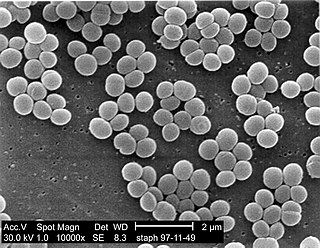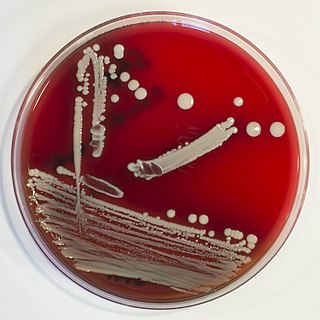Staphylococcus lugdunensis is a coagulase-negative member of the genus Staphylococcus, consisting of Gram-positive bacteria with spherical cells that appear in clusters.

Staphylococcus is a genus of Gram-positive bacteria in the family Staphylococcaceae from the order Bacillales. Under the microscope, they appear spherical (cocci), and form in grape-like clusters. Staphylococcus species are facultative anaerobic organisms.

Staphylococcus condimenti is a Gram-positive, coagulase-negative member of the bacterial genus Staphylococcus consisting of single, paired, and clustered cocci. Strains of this species were originally isolated from fermenting soy sauce mash and are positive for catalase, urease, arginine dihydrolase, nitrate reductase, beta-galactosidase, and phosphatase activity.
Staphylococcus chromogenes is a Gram-positive, coagulase-negative member of the bacterial genus Staphylococcus consisting of clustered cocci. The species is associated with mastitis in dairy animals.
Staphylococcus vitulinus is a Gram-positive, coagulase-negative member of the bacterial genus Staphylococcus consisting of clustered cocci. The species was originally isolated from food and animals and was named Staphylococcus vitulus. The name was later changed to Staphylococcus vitulinus for correct Latin grammar.
Staphylococcus stepanovicii is a Gram-positive, coagulase-negative member of the bacterial genus Staphylococcus consisting of single, paired, and clustered cocci. The species is novobiocin-resistant and oxidase-positive. It was named in honor of Serbian microbiologist Srdjan Stepanović.
Staphylococcus arlettae is a gram-positive, coagulase-negative member of the bacterial genus Staphylococcus consisting of clustered cocci. It has been isolated from the skin of mammals and birds and is novobiocin resistant. A strain of this species isolated from effluent from a textile factory was found to be able to degrade azo dyes.
Staphylococcus simiae is a Gram-positive, coagulase-negative member of the bacterial genus Staphylococcus consisting of clustered cocci. This species was originally isolated from the gastrointestinal tract of South American squirrel monkeys, Saimiri sciureus, and found to be genetically similar to S. aureus, but more biochemically similar to S. piscifermentans. A draft genome of S. simiae was sequenced.
Staphylococcus rostri is a Gram-positive, coagulase-negative member of the bacterial genus Staphylococcus consisting of clustered cocci. This species was originally isolated from the noses of healthy pigs; the name is derived from the Latin rostrum or "the snout of a swine".
Staphylococcus microti is a Gram-positive, coagulase-negative member of the bacterial genus Staphylococcus consisting of clustered cocci. This species was originally isolated from viscera of the common vole, Microtus arvalis. It is genetically similar to Staphylococcus rostri.
Staphylococcus sciuri is a Gram-positive, oxidase-positive, coagulase-negative member of the bacterial genus Staphylococcus consisting of clustered cocci. The type subspecies S. sciuri subsp. sciuri was originally used to categorize 35 strains shown to use cellobiose, galactose, sucrose, and glycerol.
Staphylococcus delphini is a Gram-positive, coagulase-positive member of the bacterial genus Staphylococcus consisting of single, paired, and clustered cocci. Strains of this species were originally isolated from aquarium-raised dolphins suffering from skin lesions.
Staphylococcus equorum is a gram-positive, coagulase-negative member of the bacterial genus Staphylococcus consisting of clustered cocci. Originally isolated from the skin of healthy horses, this species contains a cell wall similar to that of Staphylococcus xylosus.
Staphylococcus fleurettii is a Gram-positive, coagulase-negative member of the bacterial genus Staphylococcus consisting of single, paired, and clustered cocci. Strains of this species were originally isolated from raw-milk goat cheese.
Staphylococcus massiliensis is a Gram-positive, coagulase-negative member of the bacterial genus Staphylococcus consisting of clustered cocci. Strains of this species were first isolated from a human brain abscess and were found to be most closely related to Staphylococcus piscifermentans, Staphylococcus condimenti, Staphylococcus carnosus subsp. carnosus, Staphylococcus carnosus subsp. utilis, and Staphylococcus simulans. A subsequent study found that S. massiliensis may actually be part of the human skin microbiome and may have been a contaminant of brain abscess-derived samples.
Staphylococcus piscifermentans is a Gram-positive, coagulase-negative member of the bacterial genus Staphylococcus consisting of clustered cocci. This species was originally isolated from fermented fish in Thailand. A later study found a strain of S. piscifermentans in dog feces. The species is used in the preparation of fermented foods along with Staphylococcus carnosus; both species reduce nitrate and produce ammonia.
Staphylococcus intermedius is a Gram-positive, catalase positive member of the bacterial genus Staphylococcus consisting of clustered cocci. Strains of this species were originally isolated from the anterior nares of pigeons, dogs, cats, mink, and horses. Many of the isolated strains show coagulase activity. Clinical tests for detection of methicillin-resistant S. aureus may produce false positives by detecting S. intermedius, as this species shares some phenotypic traits with methicillin-resistant S. aureus strains. It has been theorized that S. intermedius has previously been misidentified as S. aureus in human dog bite wound infections, which is why molecular technologies such as MALDI-TOF and PCR are preferred in modern veterinary clinical microbiology laboratories for their more accurate identifications over biochemical tests. S. intermedius is largely phenotypically indiscriminate from Staphylococcus pseudintermedius and Staphylococcus delphini, and therefore the three organisms are considered to be included in the more general 'Staphylococcus intermedius group'.
Staphylococcus schleiferi is a Gram-positive, cocci-shaped bacterium of the family Staphylococcaceae. It is facultatively anaerobic, coagulase-variable, and can be readily cultured on blood agar where the bacterium tends to form opaque, non-pigmented colonies and beta (β) hemolysis. There exists two subspecies under the species S. schleiferi: Staphylococcus schleiferi subsp. schleiferi and Staphylococcus schleiferi subsp. coagulans.
Staphylococcus agnetis is a Gram positive, coagulase-variable member of the bacterial genus Staphylococcus. Strains of this species were originally isolated from the milk and teats of cows with mastitis. This species is not known to infect humans.
Staphylococcus borealis is a bacterial species, member of the genus Staphylococcus, closely-related to Staphylococcus haemolyticus and described in 2020. Its cells are Gram positive, coccoid in shape, with a diameter of 0.65 to 1.23 µm and form clusters. Additionally, they are facultative anaerobic, coagulase negative and catalase positive. The type strain was isolated from human blood culture at the University Hospital of North Norway, in 1997. Four additional strains included in the description were isolated from skin swabs, from healthy volunteers. The genome sequence of the type strain is deposited in DNA Data Bank of Japan, European Nucleotide Archive and GenBank under the accession number JABVEJ000000000.

